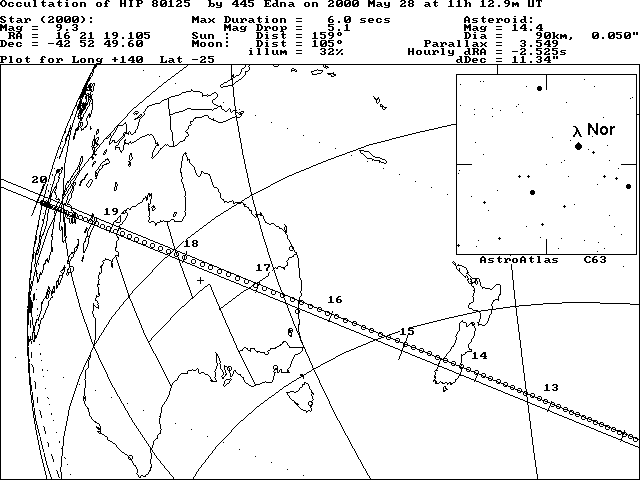ASTROMETRIC UPDATE:
OCCULTATION BY (445) EDNA - 2000 MAY 28
THIS UPDATE REPLACES THE PREVIOUS UPDATE OF 20 MAY.
CHECK THIS PAGE REGULARLY FOR FURTHER UPDATES AND CHANGES TO THE TRACK.
YOU MUST RELOAD THIS PAGE USING YOUR BROWSER'S
RELOAD/REFRESH BUTTON TO OBTAIN UPDATES!
[Prediction by Edwin Goffin]
[Prediction using OCCULT software]
[Detailed finder chart by Jan Manek]
Goffin's path crosses the Cook Strait area of New Zealand including Wellington and Blenheim. The path then crosses the southern Queensland coast around Brisbane running north-west to the sout-eastern area of the Gulf of Carpentaria. The path given by OCCULT lies around 0.4" to the south west and around 1 minute later. It crosses the South Island of New Zealand around Oamaru running to the west coast around Haast. The path crosses the New South Wales coast just north of Newcastle before running to the north-west passing just east of Darwin in the Northern Territory.
UPDATE: 25 May 2000
This prediction update has been computed by Jan Manek of the Stefanik Observatory based on astrometry from Ron Stone of the US Navel Observatory - Flagstaff Station. The Hipparcos position of the target star has been used.
Summary:
This update indicates a shift of around 5 path widths to the south-west and 2 minutes later than that given by Goffin. The path now crosses the South Island of New Zealand around Oamaru (11:14:15 UT) running to the north-west towards Haast on the west coast. The New South Wales coast is crossed at Newcastle (11:16:30 UT), running north-west near Bourke in NSW and passing just south of Darwin (11:18:55 UT) in the Northern Territory.
Observers attention is drawn to the large degree of uncertainty in this prediction. Due to the extreme southerly declination of (445) Edna in recent months resulting in observations being made from the USNO - Flagstaff Station with an asteroid altitude of barely 10 degrees, astrometric data for the asteroid has a larger than usual scatter. As a result, observers in most areas of New Zealand, New South Wales, Queensland and eastern Victoria may see the event and are therefore urged to monitor the appulse.
THE EVENT AT ONE GLIMPSE:
- Date and approx. UT time of event: May 28, 2000 @ 11:17 UT
- Magnitude of target star: 9.3
- Magnitude drop [mag]: 5.1
- Estimated maximum duration [s]: 6.0
- Path description: See above.
- Goffin's original chart reference: A00_0519
The Occultation Path:
- Approximate width [km]: 100
- Uncertainty [path widths]: 6.0
- Uncertainty in time [s]: 40
- Map: See below
- Remarks: Uncertainities are given on the basis of the nominal star position errors and the expected asteroid positional accuracy.
- Circles along the path are OCCULT calculated exact centerline points.
Data for the target star:
Data for the minor planet:
- Number, name: (445) Edna
- Approx. diameter [km]: 90
- Source of used astrometry: US Navel Observatory - Flagstaff Station (Ron Stone)
- Number of used observations: 39
- Number of rejected observations: 9
- Time covered by the observations: 1998 02 12 - 2000 05 19
- RMS residuals ["] (RA,DE): 0.17", 0.18"
- Estimated positional accuracy at epoch of event ["]: 0.30"
Data for the event:
- UT date and time of least geocentric approach: 2000 May 28, 11:12.9 UT
- Approx. V mag of minor planet at event [mag]: 14.4
- Geocentric parallax of minor planet ["]: 3.549
- Magnitude drop [mag]: 5.1
- Estimated maximum duration [s]: 6.0
- Apparent motion of minor planet ["/h]: 29.98
- Angular distance to moon, phase of moon [deg,%]: 105, 32%
- Update computed by: Jan Manek

IMPORTANT NOTE!
Astrometric updates such as these should not be taken as definitive, but rather only as an indication of where the true track may lie relative to the original predicted track. Observers must bear in mind that later astrometry, in which the target star is measured in the same field as the asteroid, may still reveal substantial changes to the predicted track and time of the event. For this reason it is most important that observers far from the predicted track still monitor the event.
Use these links for further information:
[Planetary Occultations]
[Using the Predictions]
[Observing Details]
[Timing Details]
[Reporting Details]
[Report Form]
[Asteroid Occultation Results]
This page may have been updated since 25 May 2000.
Hit your browser's RELOAD button to get the latest version.
[Site Map]
[What's an Occultation?]
[Total Occultations]
[Grazing Occultations]
[Planetary Occultations]
[Jovian Satellite Eclipses]
[Timing Occultations]
[Reporting Observations]
[Coming Events]
[Software]
[About Us]
[Publications]
[Membership]
[Links]
[Top of Page][Return to Home Page]
